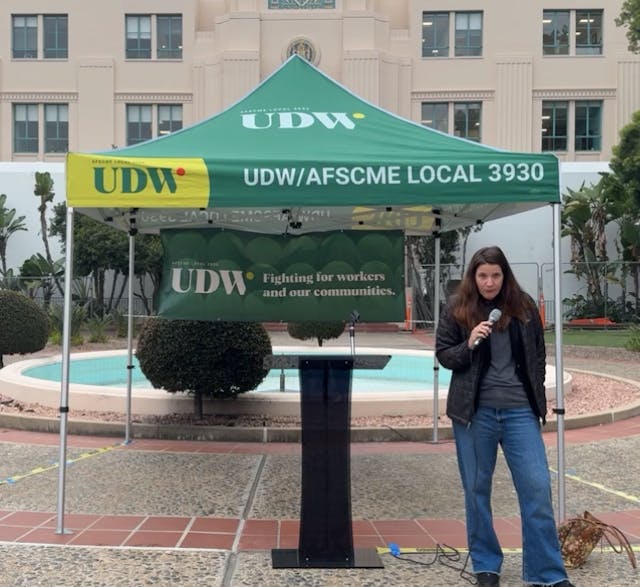Juarez Mother Seeks U.S. Political Asylum
Frontera NorteSur
Karla Castaneda has been on a rough ride for the past few years. The disappearance of her 13-year-old daughter, Cinthia Castaneda, in Ciudad Juarez more than five years ago plunged the mother into a depression that was only tempered with the aid of pills and the care of a psychotherapist.
“I wasn’t well,” Castaneda said in a recent interview with FNS.
After regaining some of her strength, Castaneda met the parents of other disappeared girls and women and founded a relatives’ committee that would become a thorn in the side of political and justice system officials in Juarez and the state of Chihuahua after 2011.
The group staged repeated protests outside the Juarez headquarters of the Chihuahua state prosecutor’s office, embarrassed officials at public events and even organized an eight-day march from the border to the state capital of Chihuahua City in the bitter cold of January 2013.
Not long after the 2013 march, state police entered and repeatedly surrounded Castaneda’s home in Juarez. Word was then leaked to the mother-turned-activist that she was going to be “levantado”-Mexican slang for forcibly disappeared.
Grabbing her four other children, Castaneda hightailed it out of town with the assistance of supporters, crossed the U.S. border at San Diego-Tijuana and asked Uncle Sam for political asylum. The former Ciudad Juarez resident spent four days in immigration detention before she was released pending a court decision on her asylum request.
Now residing in New Mexico, Castaneda recalled how she once thought stories about the violence in her hometown were sensationalized.
“I had heard about the other (women’s) disappearances, but I never thought it would happen to me,” she confessed.
Residing in her Juarez since she was four years old, Casta-neda described what might be considered a typical life in the border city. While her husband worked construction, she labored as a low-paid factory employee, or maquiladora worker, for about $40 per week.
For the Castanedas, the nightmare began early one Friday morning in October 2008, when Cinthia, who had just turned 13, boarded a city bus for downtown Ciudad Juarez to buy school material and shoes. Now expressing deep regrets for not accompanying Cinthia, Castaneda said the birth of a new child prevented her from accompanying her daughter.
A plain but intense-speaking woman, Castaneda said Cinthia was in her first year of middle school, loved cooking and dreamed of becoming a nurse when she grew up. Although the young girl didn’t have many friends, she was very close to a brother, the mom added.
When Cinthia did not return by the early afternoon, Castaneda said she and her husband immediately went to report their child’s disappearance to the state prosecutor’s office, where they were told the couple would have to wait 72 hours to file a formal complaint. By the same evening, however, news of Cinthia Castaneda’s disappearance was broadcast on local news channels, according to her mother.
Eight days later, a woman who identified herself as “Hilda” phoned Castaneda to tell her that she had spotted a girl who resembled Cinthia in the same area where the teen reportedly went to shop.
The caller said the girl, who appeared to be crying, was being grabbed and led down the street by a much older man. “Hilda,” however, disengaged from any further contacts after state investigators dialed the woman back and warned her against telling lies, Castaneda said.
In October 2008, Ciudad Juarez was in the throes of the so-called narco war that would devastate the border city over the next few years. Thousands of armed men- police, soldiers and gang hit men-roamed the streets and violence and impunity reigned supreme.
Cinthia Castaneda was among the first in a new wave of young girls and women who disappeared in the recent war years. The victims’ profiles-students or workers from lower socio-economic backgrounds-were uncannily similar to an earlier wave of young women who disappeared during the 1990s and early 2000s.
In both periods of time, the reported zone of numerous disappearances was the same: downtown Ciudad Juarez. A dozen girls from Cinthia’s neighborhood on the outskirts of the sprawling city, set below the barren mountain that’s lettered with the words “The Bible is the Truth,” were among the latest group of the disappeared, according to Castaneda.
Many of the earlier missing girls and women were later found murdered and dumped in common burial sites that became internationally known-Lote Bravo, Lomas de Poleo, Cristo Negro and Campo Algodonero.
By late 2011, the earlier pattern was repeated when female human remains were discovered in the Navajo Arroyo in the Juarez Valley, a rural area southeast of the city that was crawling with government security forces and underworld gunmen.
At least 14 murder victims, all of whom had disappeared from Juarez between 2009 and 2011, have since been recovered from the site. Yet Cinthia Castaneda was not among them. Officially, she remains missing and is listed on the web page of the state prosecutor’s office dedicated to missing women and children.
Joining the relatives of other missing or murdered girls and women, Castaneda pressed her demands for the safe return of her daughter. In the beginning, investigators told her they were back-logged and had “other priorities” to attend, with as many as 20 cases stacked up at a time, the distraught mother said.
Later, Castaneda said she discovered that her daughter’s file only contained interviews with family members and no evidence of a police search.
As time passed, the issue only got hotter.
At one point, Castaneda said she and others who had met with Chihuahua Gov. Cesar Duarte were threatened by armed men, seemingly state police, about an hour-and-a-half after the meeting. The men followed the activists in a vehicle, parked near the group’s car, rolled down a window and showed off guns while staring at the startled onlookers.
Among Castaneda’s fellow passengers was her lawyer at the time, Francisca Galvan, who represented other families of the disappeared as well. Galvan also fled Juarez in 2013, and was granted U.S. political asylum earlier this year.
“I don’t want to lose the hope that there is no solution, because I still have hope that as organizations and civil society we can find a solution…,” Galvan said in a 2011 interview. “It would be a failure for the people of Mexico if no solution is found to (disappearances) which have existed since 1993.”
Addressing a Juarez protest outside the state prosecutor’s office, Galvan called the missing girls and women “the future of our country,” and individuals who could go on to become doctors and lawyers.
The stories of Castaneda and Galvan are by no means unique. In recent years, an undetermined number of Mexicans- men, women and children- have fled from the violence tearing up their country.
An organization, Mexicans in Exile, has even been formed to represent persons who come to the United States for politically-connected reasons. “We’re growing,” said the group’s president, Cipriana Jurado, in a phone interview.
Jurado said many of the organization’s members are scattered up and down New Mexico’s Rio Grande Valley and El Paso and Hudspeth counties in Texas.
As a member of the old Southwest Network for Environmental and Economic Justice, Jurado became a well-known face to activists in New Mexico and other parts of the United States for her leadership of Ciudad Juarez’s Worker Research and Solidarity Center, an organization which advocated for the labor and environmental rights of factory workers and residents of neighborhoods near the foreign-owned plants that ring the Mexican border city.
A former factory worker, Jurado also worked with the mothers of disappeared and murdered women, and especially after 2008, took an active and very visible role in criticizing the Mexican army for alleged human rights abuses during the so-called narco war.
In early 2010, Jurado’s friend and fellow army critic, Josefina Reyes, was murdered. Not long afterward, Jurado fled to the United States and was eventually granted political asylum.
The exile said it was “very grave” that a mother like Castaneda would have to “go through these things,” with the episode pointing out the gravity of the security and human rights situation still present in Juarez.
In terms of official assurances that the city is back to safety and stability, Jurado contended that “government is always going to say this but the reality is different.” The exiled activist called for “serious investigations” to get to the bottom of the truth about the disappeared.
Nationally, the human rights panorama is not much different than in Juarez.
In a Mexico City meeting last week, the National Network of Women Human Rights Defenders of Mexico (RNDDHM) met with representatives of the international Committee for the Elimination of Discrimination against Women and a United Nations’ working group on women’s rights to discuss the circumstances of women human rights defenders and journalists in Mexico.
According to the RNDDHM, 31 women human rights defenders and journalists were murdered from 2010 to 2014, with all the crimes lingering in impunity. The RNDDHM informed the international representatives that it had documented 118 aggressions against women activists and journalists in 2012, 202 such attacks in 2013-the first year of the Pena Nieto presidency-and 41 similar aggressions in the first trimester of this year.
According to the RNDDHM:
“It was recalled that defenders and their organizations began to document an increase of human rights violations in distinct states of the Republic within the context of the so-called drug war of Felipe Calderon and the militarization of public security, including torture, forced disappearance, extrajudicial executions and gender violence against women, and that women defenders and journalists became targets of attacks and murders while denouncing these situations.”
The issue of both missing women and men is certainly not going away anytime soon in Juarez and Mexico.
On Father’s Day, Juarez dad Jose Luis Castillo initiated a hunger strike outside the state prosecutor’s office demanding the safe return of his daughter, Esmeralda Castillo, who went missing in 2009 when she was 14 years old.
Mexico’s Office of the Federal Attorney General is offering a $125,000 reward for information leading to Esmeralda Castillo’s whereabouts.
Like some other mothers of missing daughters and their supporters, Castaneda blamed sex or organ traffickers acting with government complicity for the disappearances in Juarez. She insisted that her search for Cinthia led to the threats that forced her to flee to this country.
For now, Castaneda must wait while the U.S. government mulls her asylum petition; the final decision is expected to come down later in 2015 following an immigration court date. Similar to the predicaments of other exiles, she struggles with putting food on the table and getting her children an education.
“My fear is getting deported. I know they will kill me if I am returned to Juarez. I can’t go back to Juarez,” the Juarez exile asserted. And the irony of being so close yet so far away from her hometown doesn’t escape Castaneda. “It gives me a lot of sadness, especially when I go to El Paso and see Juarez from the bridge,” she lamented. .






